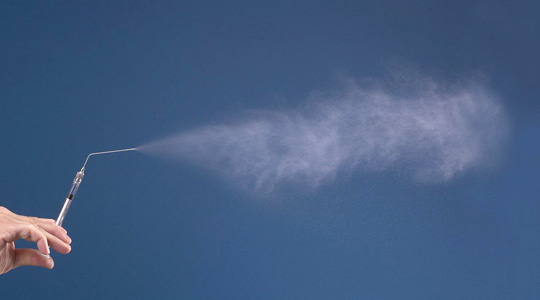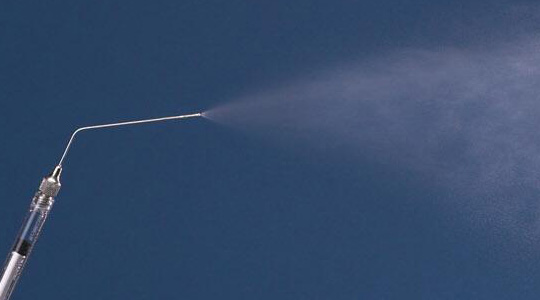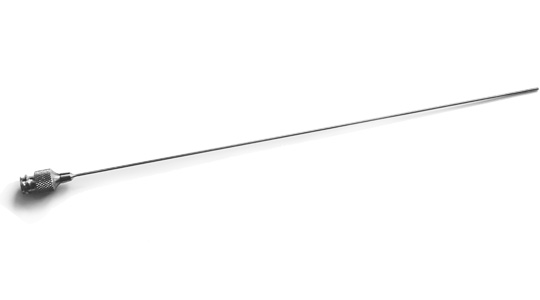
Model Number:
IA-1B-C
The MicroSprayer® Aerosolizer – Model IA-1B is available in two standard sizes – for intratracheal use in rat or guinea pig – or in custom sizes in any length of your choice. Devices can be straight or have 120-degree bend, depending on your intended use.
Custom devices can be made to order for special, non-standard, intratracheal or intranasal, in vivo or ex vivo applications, or for in vitro experimental laboratory set-ups. Some examples include custom-length devices that are long enough for intratracheal use (usually via an endotracheal tube) in: rabbits, ferrets, dogs, cats, chickens, pigs, sheep, monkeys, horses, etc. Other examples include use for in vitro aerosol particle of feasibility testing or cell culture exposure.
- To help us understand what device and length will best serve your needs, please complete and submit the Custom Device Questionnaire
- To help you determine measurements for a custom length Model IA-1B, click on the ‘Diagram’ tab on this page or download: Guide to Measuring a STRAIGHT Custom-length MicroSprayer – Model IA-1B OR Guide to Measuring a Custom-length MicroSprayer – Model IA-1B WITH BEND
- For planning for information on using of a custom length Model IA-1B, see: Instructions for use of Penn-Century MicroSprayer® Aerosolizer Model IA-1B
The MicroSprayer® Aerosolizer – Model IA-1B is designed for fast, targeted aerosol administration. The device generates a precisely quantifiable, highly-concentrated, air-free plume of liquid aerosol directly into the lungs or other locations. The device can aerosolize a wide range of liquids or particle solutions/suspensions, including pharmaceutical, and biologic formulations, contrast/imaging agents and toxicological materials. (It is does not administer dry powders.)
- Made of rigid (not flexible) 19-gauge stainless steel tubing
- Quick, precise aerosol dosing directly to the lungs – with no waste
- Purely mechanical, air-free technology
- Uses no heat, propellant, ultrasound or compressed air. No air burden to subject.
- Unique patented design is light weight, hand-held, easy to use
- Rounded tip permits safe, gentle intratracheal insertion
- Made of rigid stainless steel tubing and other chemically resistant components
- Fully sterilizable, autoclavable and reusable
- Delivers a far higher volume and concentration than is possible with nebulizer/inhalation systems
- Produces a far broader, more uniform distribution than liquid bolus/droplet instillation methods
- Materials: Based on rigid, 19-gauge, stainless steel tubing and other chemically resistance components
- 120-degree bend or straight: A custom-length MicroSprayer® Aerosolizer Model IA-1B is available in any length or size – straight or with a standard 120-degree bend. (See ‘Diagram’ tab for specifics on how to measure a straight or bent device.)
- Length of intratracheal portion: To be determined by user
- Tip is rounded to avoid harm to delicate tissues during insertion.
- Operates with: Commercial, gas-tight 0.5ml precision glass syringe or 1 ml disposable polycarbonate syringe. NOTE: Due to the pressure required, syringes larger than 1 ml cannot be used to operate the Model 1A-1B.
- Dose range: Designed to administer one dose at a time. Maximum dose size: 0.5 ml (glass) or 1 ml (polycarbonate). Smallest dose may need to be tested by end user. For doses larger than maximum capacity of the syringe, one syringe may be detached and refilled multiple times, or multiple syringes may be preloaded, attached and used one by one.
- Outer diameter: .042″ (1.1 mm) except at tip which is .048″ (1.2 mm)
- Inner diameter: .032″ (.813mm) (NOTE: liquid passes through patented aerosol components at the very tip. The diameter of these passageways is approximately 140 microns wide.)
- Re-usable/Sterilizable: Can be cleaned and sterilized with very hot (filtered or distilled) water, organic solvents, by autoclave or ultrasound.
When analyzed with water, using the ml (1cc) polycarbonate syringe provided, the MicroSprayer® Aerosolizer – Model IA-1B produced a particle size distribution with a Mass Median Diameter (MMD) of 25-30 µm – when analyzed by laser defraction. NOTE: Results may vary, depending upon method of particle size analysis used, the material delivered and the length of the MicroSprayer® Aerosolizer
The following devices are helpful when working with a custom-length MicroSprayer® Aerosolizer – Model IA-1B. NOTE: It is not possible to substitute a large volume plastic or glass syringe.
- Small Animal Laryngoscope – Model LS-2-C for Larger Species
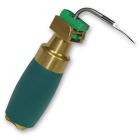
Model Number: LS-2-C Instructions for use Description Specifications Diagram User Info Penn-Century’s Small Animal Laryngoscope Model LS-2-C is specifically designed for custom applications in laboratory animals larger than mouse, rat or guinea pig – such as rabbit, ferret or small primates. (Please contact us to discuss your requirements.) The device provides bright, clear illumination for… Continue reading
- Small Animal Laryngoscope – Model LS-2-C for Larger Species
- Reverse Cleaning Adapter — Model RCA-1B
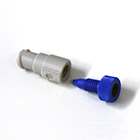
Model Number: RCA-1B Description User Info A new tool to clear blockages in the tip of your MicroSprayer® Aerosolizer Model IA-1B. The Penn-Century MicroSprayer® Aerosolizer – Model IA-1B is a unique, air-free atomizer. It generates an aerosol when liquids, solutions or particle suspensions are pushed at high manual pressure through tiny patented aerosolizing components in… Continue reading
$55.00
- Reverse Cleaning Adapter — Model RCA-1B
- 500 µl Glass Syringe

Model Number: B-SYR-GL500 Description Commercial 0.5 ml (500 microliter) precision glass instrument syringe with luer-lock fitting. Sterilizable and reusable. This syringe can be used with any MicroSprayer® Aerosolizer Model IA-1B. Syringes are GAS-TIGHT and have a PTFE (Teflon™) plunger tip that creates a tight connection between the syringe barrel and plunger for optimal aerosol performance.… Continue reading
$95.00
- 500 µl Glass Syringe
- 1 ml Polycarbonate Syringe
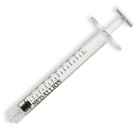
Model Number: B-SYR-PL1000 Description Commercial 1 ml polycarbonate syringe with luer-lock fitting. Disposable. This syringe can be used with any MicroSprayer® Aerosolizer Model IA-1B. Syringes are GAS-TIGHT and have a silicone plunger tip that creates a tight connection between the syringe barrel and plunger. Male luer taper with a polycarbonate hub. Because of its larger… Continue reading
$3.90
- 1 ml Polycarbonate Syringe
All Penn-Century aerosol drug delivery devices are available in custom lengths for intratracheal or other uses in larger species, in other locations of the body, or in in-vitro, ex-vivo, or other experimental laboratory set-ups. The intratracheal portion (Length A) may be straight, or have a bend. For optimal intratracheal aerosol deposition in the lung and to avoid injury to the animal, the device must be measured correctly to assure that the portion inserted into the trachea is long enough to reach near to but not touching the carina (first bifurcation). In larger animals it may also be possible to insert the device in one lung, if desired. It is the responsibility of the user to determine the correct measurement for their particular use.
For custom length, straight devices, the length “A” must be specified, as shown:

For custom length devices with a 120-degree bend, the length “A” must be specified as shown:
Dimensions (approx.)
| A | B | C |
|---|---|---|
| ?? | 120° | 1″ |
Key:
Length “A”: Functional length, from bend to tip
Angle “B”: Angle of bend
Length “C”: Length from hub to bend
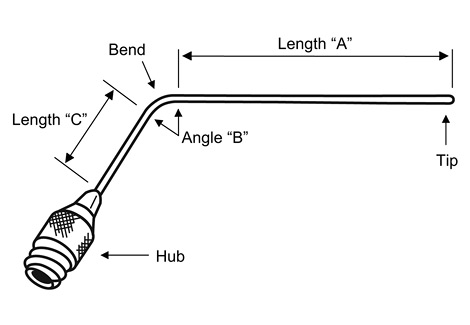
For intratracheal applications, a custom length MicroSprayer® Aerosolizer can be inserted directly into the trachea or inserted down the trachea to the carina via an endotracheal tube. Doing so requires that the user calculate the measurements carefully so that:
- the tip of the MicroSprayer® Aerosolizer is long enough to emerge slightly from the end of the endotracheal tube when it is in position, and
- neither the tip of ET tube nor the tip of MicroSprayer® Aerosolizer should make contact with the carina when the plunger of the syringe is pushed
- The intratracheal portion must reach from the front incisors to the carina.
- For a better understanding of how to determine measurements for a custom length Model IA-1B, see: Guide to Measuring a Custom-length MicroSprayer – Model IA-1B
- For planning for use of a custom length Model IA-1B, see: Instructions for use of Penn-Century MicroSprayer Aerosolizer Model IA-1B Custom
- You will be required to confirm your final measurement prior to ordering.
Intratracheal use of Penn-Century devices
For best results, position the tip
of the device near to – but not
touching the carina, or first
bifurcation.
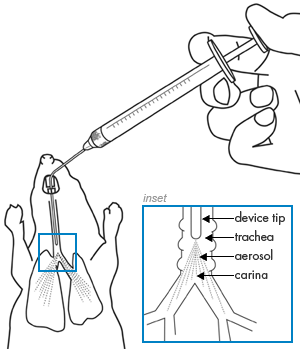
The process of intratracheal administration is essentially a form of intubation. For intrapulmonary applications, the tip of the MicroSprayer® Aerosolizer is gently inserted down the trachea of the anesthetized animal – near to, but not touching the carina (first bifurcation). The device operates with either a 0.5ml glass syringe or a 1 ml polycarbonate syringe.
For other planning help, see our Instructions for Use of the MicroSprayer® Aerosolizer Model IA-1B.

